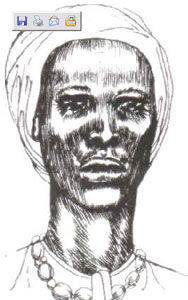
It is night in the Blue Mountains. The year is 1734. There is no noise save the occasional hoot of an owl or the shriek of a bat enjoying its evening feast. A visitor might think the place uninhabited, but this is a warrior’s camp – Maroon soldiers and look outs are posted along every ridge, high up in the trees, behind every shadow. They are cloaked in darkness and covered in branches, hiding among the lush foliage. A few hours before morning approaches, we hear the tramp-tramp-tramp of black British boots on Maroon soil – the British soldiers, in their bright red uniforms and big black boots, with their loud laughter and disregard for their environment, are a stark contrast to the Maroon soldiers. The British have come to capture what they feel is rightfully theirs – escaped or never captured Africans who they view as slaves, the rightful property of the British government.One Brit, a straggler, comes to rest in a clearing, puts his gun down and leans back against a tree to catch his breath. He looks up to the sky, enjoying the peace and quiet of the night and wondering when they will reach the elusive Nanny Town so they can finally burn it to the ground. Suddenly, the “tree” he was leaning against comes to life, and with a whispered word in a language he has never before heard, slits the soldier’s throat.
I was told this story, with slight variations, by Major Charles Aarons of the Mooretown Maroons in 1994. Maj. Aarons was, at the time, the democratically elected second-in-charge at the time, under Col. C.L.G. Harris. The two were put in place by a council of 24 women who were in turn picked by the modern Maroon people to run things in Mooretown, a town that is also called “New Nanny Town” because that is where the people moved to when Nanny Town was finally burned after about 50 years of warfare in 1734. The most significant leader of the Windward, or Eastern, Maroons was, of course, the legendary Queen Nanny. Brilliant strategist, spiritual leader, sustainer of hope, diplomat, nurturer, Nanny is the kind of leader that inspirers legends and changes the world. In fact, I would argue that Nanny had at least two significant contributions that changed the direction of the modern world: first, she developed Guerrilla warfare and the tactics she used were later studied by military strategist in the Vietnam War and others. Second, because she and her people established the first independent black polity in the New World, she led the way for freedom struggles in Haiti, Brazil, the U.S., Guadelope, Surinam… – anywhere where there were enslaved Africans. Without the work of the Maroons under her leadership, I believe the world would be a different place.
Nanny, a wise and great leader who changed the history of the world, is indeed the mother of Jamaica. Her legend lives on in this great island nation – her image graces the 500 bill (the ‘Nanny Note’), she is referred to in song, poetry, verse and every day language, and she is one of seven National Heroes (the only female and the only Maroon to be so honored). Some argue[1] that because of Nanny’s influence, the Maroons and people in the surrounding area of Mooretown are more egalitarian, and that women have greater rights than in the rest of Jamaica.Queen Nanny has alternatively been called “ubiquitous,” “formidable,” “the mother nurturer of a nation,” and it is said that, “her legendary spirit evokes pride among her people, and among all Jamaicans.”[2] Incredible legends are told of this warrior queen. It is said that she was able to catch bullets and fire them back at the British. It is said that she possessed magic (also called obeah, Science, or myal) and had incredible psychological control over the British, who were deathly afraid of her and her powers. One story recounts the tale of the “Nanny Pot,” a huge cauldron of boiling liquid strategically placed on a mountain trail on the way to Nanny Town. When the British soldiers would look in the pot, they would suddenly look in and die. Each soldier coming up the single file path would meet with this same end, except for the last one, who Queen Nanny would save. She would bade him look in the pot where all the soldiers had died, and send him back home to tell his general what he saw, this further instilling the magical power of the leader. In fact, some hypothesize that this cauldron was actually the convergence of two rivers, where the water appeared to boil. The rebel queen, who was a wise herbologist, would put herbs in the water that had a chloroform-like effect. As the soldiers approached, they would inhale the vapors, become drugged, and fall in to their deaths.
Another story recounts a time when the Maroons were at the brink of starvation and Queen Nanny was considering surrendering to the British. She heard a voice in her head tell her not yet, wait one more day. When she awoke the next morning, she found three pumpkin seeds in her apron pocket. The voice told her to plant them. She planted them on the side of a mountain now known as Pumpkin Hill, and in a very short time, the seeds grew to fruition with large pumpkins that saved the Maroons from starvation. This story is often cited when scholars refer to Nanny’s nurturing qualities, and her ability to care for her people like a mother earth deity.
I would argue that Queen Nanny is not only the “mother of a nation,” but also the Mother of Us All. As Edward Kamau Brathwaite so eloquently states,
Nanny both physically as priestess and metaphysically as queen-mother, not only contributed important inputs of personal leadership to her embattled group, but by miraculously keeping alive and adapting to the new conditions the survival rhythms of her past homeland, helped make it possible not only for her own group to survive with dignity and some respect from the other; but, by her victorious presence in and through the groups, helped to make it possible for African culture itself to survive in a hostile slave and materialist environment in such a way that that culture, instead of being eradicated, was able to survive and subterraneously contribute to what is emerging as the complex and unique “creole” culture of our time. [3]
The lessons that can be learned from her leadership affect all of us. Her wisdom, openness to incorporating elements from other cultures like the Arawak and other African nations, her strength, and her spirituality inspire all of us. I think if we could all see her as a model – of resistance, determination, and strength against all odds – the world would be a better place, and we would all be able to see what is not visible, what is on the other side of the visible world.
[2] As quoted in Gottlieb, Karla. The Mother of Us All: A History of Queen Nanny of the Windward Jamaican Maroons. Trenton, NJ: Africa World Press, 2000, p. 79.
[3] Brathwaite, Edward Kamau. Wars of Respect: Nanny and Sam Sharpe. Kingston, Jamaica: Agency for Public Information, National Heritage Week Committee, 1976, pp. 17-18.









